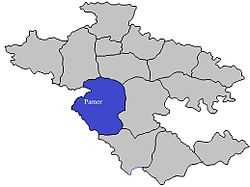Pimpri Gawali
| Pimpri Gavali पिंपरी गवळी | |
|---|---|
| Village | |
 Pimpri Gavali Location in Maharashtra | |
| Coordinates: 18°54′50″N 74°34′34″E / 18.91389°N 74.57611°ECoordinates: 18°54′50″N 74°34′34″E / 18.91389°N 74.57611°E | |
| Country | India |
| State | Maharashtra |
| District | Ahmednagar |
| Taluka | Parner |
| Population (2012) | |
| • Total | 1,150 |
| Pincode | 414302 |
Pimpri Gawali (Marathi: पिंपरी गवळी) is a village in Parner taluka in Ahmednagar district of the state of Maharashtra, India.[1]
It is about 25 km from Ahmednagar, and it is well known for the watershed development and agribusiness activities. This village received "Goduli Gram Puraskar" from Mankanhiayya Trust of Dr. Sudha Kankariya due to higher birth rate of female babies.
Model Village
This village is selected under "Model Village" scheme of the government of Maharashtra. Anna Hazare was behind the selection of this village, based on its geography and potential for watershed development work. Popatrao Pawar is leading the implementation of this scheme. NGO Adhar Krishi Vikas Pratisthan, Parner is the implementing agency for the work. Villagers purchased a moving earth excavator for the price Rs. 45 lac for their watershed activities.

Local self government (gram panchayat)
Gram Panchayat is the basic unit of the governance in the village. It has seven members elected by gram sabha. Radhuji Babu Thorat is the Sarpanch of the village. Under funds of 13th finance Commission, computerization of the Panchayat is done. Gram panchayat provided job cards to all the eligible people who are interested to work on MG-NREGA Work. The gram panchayat received "Mahatma Gandhi Tanta Mukti Village Award" in 2011 by the government of Maharashtra. Grampanchayat had taken initiative to complete toilets of all households and completed about 80%. Mr. Adsul is the Gramsevak of the Panchayat.
Govt’s Re 1 becomes Re 2 in village
Rajiv Gandhi was widely quoted by saying that Govt’s One Rupee remains only 15 Paisa when it reaches to the villages. But the villagers of the Pimpri Gawali have set precedent worth emulating. This village displays a unique example of govt- people participation where corruption level is zero.The village shows the ways how to utilize government fund for development. It becomes significant after the announce ment of the PM Narendra Modi on 15 AUG 2014 that one MP has to develop one village every year. The simple reason of doubling the amount provided by the government for any project is that village has developed habit of performing “Shramdan in every Government t Project by adding almost same amount by villagers. Villagers has purchased worh Rs 45 Lac moving earth exvator for the watershed development activities. In 2013 GSDA (Groundwater Survey and Development Agency ) Ahmednagar sanctioned Rs 2.18 Lac for the widening of the water streams under National Drinking Water Project. Villagers done good work and GSDA officially mentioned work done of worth Rs 3.98 Lac in MB recording of Panchayat. The prime motivation behind the marvelous change is the mindset. Every Paisa utilized here speaks itself.
Groundwater Regulation and Management, Resolution, 2013
This resolution received the assent of the Gramsabha of village Pimpri Gawali based on the power authority and responsibilities conferred to the Grampanchayat under Article 243G of the Constitution of India under entry 3 (Minor irrigation, water management and watershed development) of the eleventh schedule on 22 March 2013 on the World Water Day.
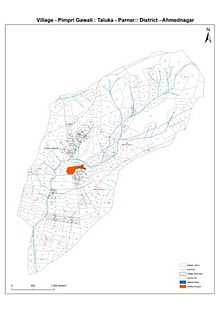
1. Short title, extent and commencement (1) This Resolution may be called the Groundwater Regulation and Management, Resolution, 2013 (2) It extends to the revenue area of the village Pimpri Gawali (3) It shall come into force on 1 April 2013 and will be valid up to 1 April 2018. This limit can be extended by the Gramsabha on or before the expiration of that period
2. Objective of the Resolution (1)The exploitation of groundwater should be regulated with reference to recharge possibilities and consideration of social equity. The detrimental environmental consequences of over- exploitation of ground water need to be effectively prevented. (2)We have to shift From Private ownership of groundwater and uncontrolled extraction To Groundwater as Common Property Resource (CPR), community management of aquifers, regulated use.
3. Groundwater regulation is as per following (1) No Person shall dig bore well into PIMPRI GAWALI village up to 1 April 2018. (2) This limit can be extended by GramSabha on or before the expiration of the said period
4. Offences and Penalty (1) Disobedience of this resolution is punishable offence. (2) There is penalty of Rs. 5000/- to the farmer who break the rule of GramSabha (3) The bore well machine operating agency will have penalty of Rs. 10,000 and Groundwater regulation and management committee will file an FIR against that agency under Indian Penal Code section 188 for disobedience of the order of the Grampanchayat. PROVISIONS RELATING TO GROUNDWATER MANAGEMENT
5. Establishment of the Groundwater Regulation and Management Committee
6. Groundwater User Associations
7. Water Harvesting and Artificial Recharge
8. Social Afforestation
9. Water Security
10. Groundwater Tax
Rainwater harvesting "PIMPARI GAVALI PATTERN"
Pimpari Gavali is located in the rain-fed zone of Maharashtra state. Rain is the only source of water. Rainwater harvesting is the accumulation and storage of rainwater for reuse before it reaches the aquifer. The water collected is redirected to a deep pit with percolation. Rainwater harvesting provides water when there is a drought. Rainwater harvesting prevents flooding of low-lying areas. Rain water harvesting replenishes the ground water table, which enables the dug wells and bore wells to yield in a sustained manner. It helps in the availability of clean water by reducing the salinity and the presence of iron salts. Deep continuous contour trenches (CCT) structures are used for the rainwater harvesting, in the hills that cover about 1/4 of the area of the village. The deep CCT, with dimensions of 1 meter wide and deep, are dug across the hills and prevent the direct runoff of the rainwater. The deep CCTs cover 317 hectares.
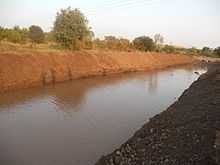
Deep CCT study
Watershed development projects considered rainwater harvesting structures as the basic tools for water security. The present paper reveals the impact of one of such rainwater harvesting structure called deep continuous contour trenches (CCT) under ‘Adarsh Gaon Yojana’ of the government of Maharashtra which is based on the in-situ water conservation. The study was carried out in the village Pimpari Gavali of Ahmednagar district of Maharashtra to find out the impact of the Deep CCT structures. These structures have distinctive features such as low cost, ban on grazing, plantation along it.
The main findings of the study were that the majority of the area was not irrigated due to depletion in the groundwater table. Farmers were exploiting the groundwater with the help of tube well having average depth of 300 feet. There was nobody thinking about the groundwater recharge. There was no groundwater, and farmers were wasting their money by digging tube wells. Before starting the work of deep CCT, Gramsabha passed the resolution of the ‘Groundwater Regulation and Management’ which prohibited the villagers from digging tube wells (the main cause of the groundwater depletion). These helped to recharge the groundwater. It was found that due to Deep CCT structures water availability became major asset in the village which result into increase in the crop production and productivity. And farmers are shift toward cultivation of cash crops. Similarly due to availability of the water for the cultivation of fodder crops, dairy became a profitable enterprise. Thus a deep CCT structure has great success in the transformation of village Pimpari Gavali in very short span. It is definitely a replicable model.
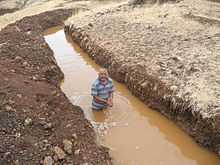
"Nirmal Gaon" (Clean Village)
As a part of the total sanitation programme each household has provision for a toilet with the facilities of water. The programme has been re-oriented to focus the sanitation programme for achieving an open defecation free (ODF) environment. Thus, not only individual households but also communities, village, schools and Anganwadi Centres have constructed toilets. The strategy used for the fully open defecation free village was behavioral change communication activities, capacity building, school sanitation and hygiene education. Sampatrao Mandage, a retired police officer, and Bhausaheb Baburao Thorat, constructor, had excellent participation in implementation of this total sanitation programme. Swachh Pimpri Mission Responding to the Prime Minister of India Narendra Modi's call for the Swachh Bharat Mission, Gramsabha of pimpri gavali decided to launch Swachh Pimpri Mission on 2 October 2014. This mission seeks to create clean Pimpri. This seeks to plan and engage every household in the task of cleaning their homes, work places and surrounding.
Participatory Forestry
The aim of participatory forestry is to improve the lives of the farming community through the conservation and sustainable management of forests and other natural resources. It creates livelihood opportunities, including for women, by supporting them in planting forest trees and building capacity for natural resource management. Activities focus on capacity building; the production of forest plants in home-based nurseries; agro forestry; the establishment of forest plantations; natural forest management; soil conservation; and the formation of terraces and pits.
The component comprises the following interventions:
- Mobilizing villagers in pilot sites to support the formation of Joint Forest Management Committee (JFMC)
- Capacity-building among villagers about soil and water conservation techniques
- Ban for the open grazing of animals and ban for cutting plants
- Plantation on private lands though Shramdan.
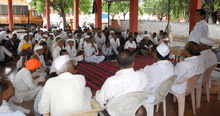


Biodiversity Management Committee
The first BMC of the Ahmednagar district was formed in the village. GramPanchayat meeting was held on 16 Dec 2013 and, with the consent of all members, biodiversity management committee was formed under the chairmanship of Sri. Dattatraya Yenare. With reference to Rule 41[1] of biological diversity Act 2002 and Rule 22 of biological diversity Rules 2004 of biological diversity Rule 2005, Village BMC is formed for the period of five years by Gramsabha.
The Biodiversity Committee will be responsible for
- Conservation and sustainable use of bio resources within its area of jurisdiction.
- Stop illegal access of bio resources within its area of jurisdiction.
- Furnishing of opinion to National Biodiversity Authority, Chennai and ... Biodiversity board as and when required.
- Levying charges by way of collection fees for accessing/collecting bio resources for commercial purpose within its area of jurisdiction as per the act.
- Maintain data about local vaidya and practitioners using biological resources.
- Maintain register containing information about details of access of biological resources and traditional knowledge granted, details of collection free imposed and details of benefit derived and mode of their sharing.
- The Biodiversity Management Committee will also be involved in documentation of biodiversity and associated traditional knowledge.
- Management of the Biodiversity fund as per guidelines provided by National Biodiversity Authority and Maharashtra State Biodiversity Board from time to time.[2]
Co-operative Institutions
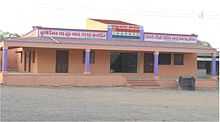
A Primary Agriculture Co-operative Society was established in the village before independence. It has about 120 producer members. As of 2013, Anandrao Tatyaba Ransigh is chairman. Krishivaibhav Co-operative Dairy was established in the 1980s and revitalized the economy of the village. Ramchandra Mandge was chairman of the Ahmednagar District Co-op Milk Producers Society.
Producer company (Farmer Producer Organization)
In changing scenario of the Farmer Producers Organisation to congregate small and marginal farmers to be professional in competitive world Producer company is registered in the village. It will act as a centre of excellence in the arena of village level primary processing and value addition along with catalyst, and as a launch pad for ideas and talent of rural agro-entrepreneurs. It is proposed to set up Agri Business Park which will be a Central processing centre for the agriculture commodities produced at the village level as well as incubation canter for the farmers to design their production system based on market linkages to maximise the profit for sustainable development. This park will comprise
- Cleaning, Grading, Packaging Facilities
- Pulses Processing Plant
- Storage Structures ( Warehouse/cold storage)
- Agriculture Machinery Bank
- Agriculture Input Services
- Milk Processing centre
Agri-business (1.0 Post Harvest Management & NWR scheme)
Farmer self-help groups (SHGs) have designed business plans for post-harvest management and marketing of sorghum (Jowar). SHGs created awareness among member farmers about storage of their produce in the local warehouse. The sorghum commodity is graded by machine, and the groups are responsible for standardization in packaging. This small intervention adds value to the commodity, which eventually results in increased income for the farmer. When graded commodity is stored in the accredited warehouse, farmers become eligible to participate in the Negotiable Warehouse Receipt Scheme. Under this scheme, the farmer can take out a loan against their warehouse receipt, from nationalized Banks, for up to 70% valuation of their commodity. This helps farmers to avoid distress sales.
Village Adoption Programme
This is unique approach to making village community acquainted with latest technologies on Agriculture and rural development. Village create symbiotic partnership with educational institutes, Universities, Non Government Organisations. These initiative not only aware villagers about most recent knowledge associated with their livelihood activities but also help to enlighten the students, academician, policy makers about grass root implementation of the technology. As a part of this programme National Institute of Food Technology Entrepreneurship and Management (NIFTEM) under the patronage of Ministry of Food Processing Industries, Government of India selected this village for their flagship Village Adoption Programme.
Religion
The majority of the population in the village is Hindu. The village is home to Khandoba Temple, a Hindu temple.
Economy
The majority of the population has farming as their primary occupation. Thanks to co-operative institutions, the area has experienced a "white revolution", and this small village produces about 5000 liters of milk per day. Livestock plays a pivotal role in the agricultural economy and constitutes one of the valuable possessions of the farmer. Most of the agricultural operations such as ploughing, harrowing, hoeing, irrigation, transport, etc., are carried out with the help of a. Cows are a source of milk. The livestock also provides much of the organic manure used on the farms. Poultry is a good option for farmers due to assured market based on contract farming. The village has five poultry sheds, with a total capacity of about 25,000 birds.
Cropping pattern
Agriculture is the main occupation of the people. The region is rain-fed and has no irrigation canals. Hence, agriculture depends upon tube wells. In Kharif season Moong, Bajara, and pigeon pea is taken. In Rabi Jowar, maize is the main crop. In summer few farmers take groundnut and onion. Now farmers are converting to high value horticultural crops, such as pomegranate orchards.
Women development
Village Gramsabha celebrate international Women's Day to empower the women. Women are the major driving force behind the rapid change in the village which achieved water security and social stability. All the villagers had taken an oath to protect the dignity of the women and to set unique example of the equality for the inclusive development. The village theme on International Women's Day 2014 was 'Role of Gender Equality in Inclusive Village Development.'
Photo gallery
-

IWD 2014 celebration
-

IWD 2014 oath to protect the women child
See also
References
http://pimparigavali.wix.com/aboutus
